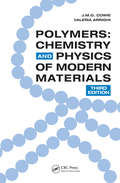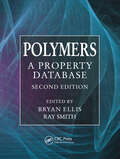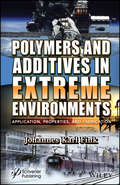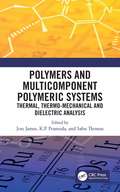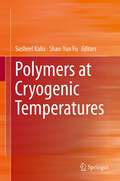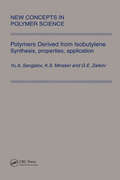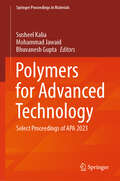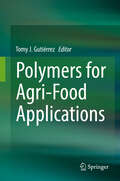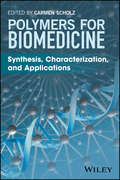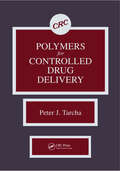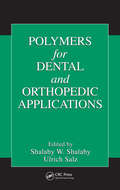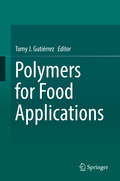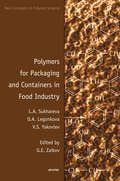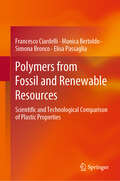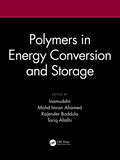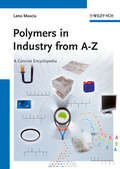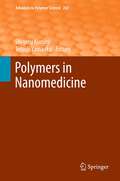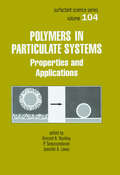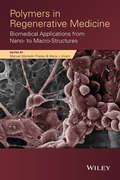- Table View
- List View
Polymers: Chemistry and Physics of Modern Materials, Third Edition
by Valeria Arrighi J.M.G. CowieUnderscoring the multidisciplinary nature of polymer science, this third edition provides a broad-based and comprehensive text at an introductory, reader-friendly level. With nearly 50 percent new or updated material, this edition presents new polymerization methods, characterization techniques, and applications in electronic, biological, and medical settings. New topics include controlled radical polymerization, novel polymer architectures, chain dimension, morphology, determining molecular weights, metallocene catalysts, copolymers, and rheological behavior. The book features real world examples, new chapter problems, and a solutions manual.
Polymers: A Property Database, Second Edition
by Bryan Ellis Ray SmithA reliable source for scientific and commercial information on over 1,000 polymers, this revised and updated edition features 25 percent new material, including 50 entirely new entries that reflect advances in such areas as conducting polymers, hydrogels, nano-polymers, and biomaterials. The second edition also comes with unlimited access to a complete, fully searchable web version of the reference. Powerful retrieval software allows users to customize their searches and refine results. Each entry includes trade names, properties, manufacturing processes, commercial applications, supplier details, references, and links to constituent monomers.
Polymers and Additives in Extreme Environments: Application, Properties, and Fabrication
by Johannes Karl FinkThe book includes chapters on aqueous environments including polymeric membranes for water purification and wastewater treatment; extreme pressure environments such as oils and lubricants for combustion engines as well as materials used for deep drilling such as surfactants, scale inhibitors, foaming agents, defoamers, proppants, fracturing fluids; extreme temperatures is subdivided in high and low temperature applications including gasketing materials, fuel tank sealants, expulsion bladders, fuel cell materials, and on the other hand, cold weather articles and thermoregulatory textiles; electrical applications include solar cell devices, triboelectric generators, fuel cell applications, electrochromic materials and batteries; medical applications include polymers for contact lenses, materials for tissue engineering, sophisticated drug delivery systems; aerospace applications include outer space applications such as low temperature and pressure, also cosmic rays, outgassing, and atomic erosion, as well as materials for electrostactic dissipative coatings and space suits; a final chapter detailing materials that are used in other extreme environments, such as adhesives, and polymeric concrete materials.
Polymers and Multicomponent Polymeric Systems: Thermal, Thermo-Mechanical and Dielectric Analysis
by Jose James Pramoda Kumari Pallathadka Sabu ThomasIn recent years, multicomponent polymers have generated much interest due to their excellent properties, unique morphology and high-end applications. Book focusses on thermal, thermo-mechanical and dielectric analysis of polymers and multicomponent polymeric systems like blends, interpenetrating polymeric networks (IPNs), gels, polymer composites, nanocomposites. Through these analyses, it provides an insight into the stability of polymer systems as a function of time, processing and usage. Aimed at polymer chemists, physicists and engineers, it also covers ASTM /ISO and other standards of various measurement techniques for systematic analysis in materials science.
Polymers and Polymeric Materials for Fiber and Gradient Optics
by L. Nadareishvili N. Lekishvili Gennady Zaikov L. KhananashviliThis book considers general aspects of the theory of polymers applied in optics. The main factors affecting the light loss in polymeric wave beam guides (PG) are discussed, and the mechanism of light loss in PG is analysed. Polymers applied in fiber optics are classified with reference to methods of fabrication and purification of the materials. Technological aspects of material fabrication are considered together with kinetic aspects of polymerisation. Updated information on polymerisation kinetics of MMA and styrene, and copolymerisation of these monomers with each other is reported. Other topics discussed in the book are heterogeneity of optic copolymers, association between structure and reactivity of monomers, other properties of optic copolymers, and areas of their commercial application. This volume will be of value and interest to anyone working in the field of optic polymers, both in academia and industry.
Polymers at Cryogenic Temperatures
by Shao-Yun Fu Susheel KaliaKalia and Fu's novel monograph covers cryogenic treatment, properties and applications of cryo-treated polymer materials. Written by numerous international experts, the twelve chapters in this book offer the reader a comprehensive picture of the latest findings and developments, as well as an outlook on the field. Cryogenic technology has seen remarkable progress in the past few years and especially cryogenic properties of polymers are attracting attention through new breakthroughs in space, superconducting, magnetic and electronic techniques. This book is a valuable resource for researchers, educators, engineers and graduate students in the field and at technical institutions.
Polymers Derived from Isobutylene. Synthesis, Properties, Application
by Yu.A. Sangalov K.S. Minsker G.E. ZaikovThis monograph aims to give an overview of recent chemical and technological developments in the area of polymers and co-polymers derived from isobutylene, which have a wide range of (industrial) applications.The scientific basis for presenting the material aEURO" application of the acid-base theory with a view to the fundamental steps of isobutylene polymerization aEURO" is combined with the application of quantum-chemical calculations of catalysts, linked active centers, separate elementary stages of the process, and critical analysis of some experimental data. In addition, a number of problems, such as the macrokinetic description of isobutylene polymerization, description of the balanced scheme of industrial production of isobutylene polymers, and initiation of isobutylene polymerization with the help of immobilized cationic catalysts are discussed. Special attention is given to ecological aspects of synthesis and application of isobutylene polymers.This book will be of value and interest to researchers in the areas of chemistry and physics of high-molecular compounds, as well as engineers and technologists specialized in the area of olefins and polyolefins.
Polymers for Advanced Technology: Select Proceedings of APA 2023 (Springer Proceedings in Materials #1)
by Susheel Kalia Mohammad Jawaid Bhuvanesh GuptaThis book presents select proceedings of the International Conference on Polymers for Advanced Technology (APA 2023). Polymers offer enormous opportunities for newer applications in technologically important areas. This book includes comprehensive step-by-step chapters with details of the processing and functionalization of polymers and their applications. This book will help the readers to know the recent developments and comprehensive research on polymers for advanced technology. All chapters in this book include illustrations, tables, figures, graphs, bibliographies, and extensive references to provide comprehensive information to the readers. This book can be a valuable reference for researchers and professionals interested in polymeric materials and biomaterials.
Polymers for Agri-Food Applications
by Tomy J. GutiérrezThis book presents an exhaustive analysis of the trends in the development and use of natural and synthetic polymer systems aimed at sustainable agricultural production. The polymers have allowed the development of controlled and released systems of agrochemicals such as pesticides, fertilizers and phytohormones through micro and nanoencapsulated systems, which protect and stimulate the growth of crops at low costs and without damage to the environment. Hydrogel systems from natural and synthetic polymers have also had their place in the agricultural industry, since they allow to maintain the humidity conditions of the crops for their correct development in drought times. Mulch films made of polymers have also become important in the control of weeds and pests in crops, as well as the use of edible coatings applied to fruits and vegetables during post-harvest, which reduce the losses of these perishable foods. Currently, the systems indicated, as well as others, are already used on a large scale. However, research studies in this area have been limited compared to other polymer applications. This book collects useful information for researchers, students and technologies related to the polymer technology and agri-food production. In this book, world-renowned researchers have participated, including associate editors of important journals, as well as researchers working in the area of research and development (R&D) of leading agri-food industries in the manufacture of agricultural inputs.
Polymers for Biomedicine: Synthesis, Characterization, and Applications
by Carmen ScholzHighlighting dynamic developments in polymer synthesis, this book focuses on the chemical techniques to synthesize and characterize biomedically relevant polymers and macromolecules.• Aids researchers developing polymers and materials for biomedical applications• Describes biopolymers from a synthetic perspective, which other similar books do not do• Covers areas that include: cationically-charged macromolecules, pseudo-peptides, polydrugs and prodrugs, controlled radical polymerization, self-assembly, polycondensates, and polymers for surface modification
Polymers for Controlled Drug Delivery
by Peter J. TarchaPolymers for Controlled Drug Delivery addresses the challenges of designing macromolecules that deliver therapeutic agents that function safely and in concert with living organisms. The book primarily discusses classes of polymers and polymeric vehicles, including particulates, such as latexes, coacervates, ion-exchange resins, and liposomes, as well as non-particulate vehicles such as enteric coatings, mediators, and bioadhesives. Other topics discussed include diffusion; biodegradation-controlled delivery; animal model studies for toxicity, metabolism, and elimination testing; and FDA requirements for clinical studies. Drug delivery researchers will find this book to be an invaluable reference tool.
Polymers for Dental and Orthopedic Applications
by Shalaby W. Shalaby Ulrich SalzRecent advances not only in the creation of new polymers but also in their processing and production have ushered in huge strides in a variety of biomedical and clinical areas. Orthopedics and dentistry are two such areas that benefit immensely from developments in polymer science and technology. Polymers for Dental and Orthopedic Applications
Polymers for Electricity and Electronics
by Jiri George DrobnyThe comprehensive, practical book that explores the principles, properties, and applications of electrical polymersThe electrical properties of polymers present almost limitless possibilities for industrial research and development, and this book provides an in-depth look at these remarkable molecules. In addition to traditional applications in insulating materials, wires, and cables, electrical polymers are increasingly being used in a range of emerging technologies.Presenting a comprehensive overview of how electrical polymers function and how they can be applied in the electronics, automotive, medical, and military fields, Polymers for Electricity and Electronics: Materials, Properties, and Applications presents intensive and accessible coverage with a focus on practical applications. Including examples of state-of-the-art scientific issues, the book evaluates new technologies--such as light emitting diodes, molecular electronics, liquid crystals, nanotechnology, optical fibers, and soft electronics--and explains the advantages of conductive polymers as well as their processibility and commercial uses.This book is an essential resource for anyone working with, or interested in, polymers and polymer science. In addition, appendices that detail the electrical properties of selected polymers as well as list additional ASTM and corresponding international testing standards and methods for testing electrical properties are also included.
Polymers for Energy Storage and Conversion
by Vikas MittalOne of the first comprehensive books to focus on the role of polymers in the burgeoning energy materials marketPolymers are increasingly finding applications in the areas of energy storage and conversion. A number of recent advances in the control of the polymer molecular structure which allows the polymer properties to be more finely tuned have led to these advances and new applications. Polymers for Energy Storage and Conversion assimilates these advances in the form of a comprehensive text that includes the synthesis and properties of a large number of polymer systems for applications in areas such as lithium batteries, photovoltaics, and solar cells.Polymers for Energy Storage and Conversion:Introduces the structure and properties of polymer hydrogel with respect to its applications for low to intermediate temperature polymer electrolyte-based fuel cellsDescribes PVAc-based polymer blend electrolytes for lithium batteriesReviews lithium polymer batteries based on ionic liquidsProposes the concept of the solar cell with organic multiple quantum dots (MQDs)Discusses solvent effects in polymer-based organic photovoltaic devicesProvides an overview of the properties of the polymers that factor into their use for solar power, whether for niche applications or for large-scale harvestingReviews the use of macroporous organic polymers as promising materials for energy gas storageReadershipMaterials scientists working with energy materials, polymer engineers, chemists, and other scientists and engineers working with photovoltaics and batteries as well as in the solar and renewable energy sectors.
Polymers for Food Applications
by Tomy J. GutiérrezThis book presents an exhaustive review on the use of polymers for food applications. Polymer-based systems for food applications such as: films, foams, nano- and micro-encapsulated, emulsions, hydrogels, prebiotics, 3D food printing, edible polymers for the development of foods for people with special feeding regimes, sensors, among others, have been analyzed in this work.
Polymers for Packaging and Containers in Food Industry
by Lidia A. Sukhareva Vyacheslav S. Yakovlev Olga A. LegonkovaThis book delineates the scientific principles of design and fabrication of packaging materials for food as well as methods for structural modification and other techniques. It describes the main practical properties and applications of polymer materials and highlights the analysis of all processes taking place during formations and destruction of
Polymers for PEM Fuel Cells
by Hongting PuIncluding chemical, synthetic, and cross-disciplinary approaches; this book includes the necessary techniques and technologies to help readers better understand polymers for polymer electrolyte membrane (PEM) fuel cells. The methods in the book are essential to researchers and scientists in the field and will lead to further development in polymer and fuel cell technologies. * Provides complete, essential, and comprehensive overview of polymer applications for PEM fuel cells * Emphasizes state-of-the-art developments and methods, like PEMs for novel fuel cells and polymers for fuel cell catalysts * Includes detailed chapters on major topics, like PEM for direct liquid fuel cells and fluoropolymers and non-fluorinated polymers for PEM * Has relevance to a range of industries - like polymer engineering, materials, and green technology - involved with fuel cell technologies and R&D
Polymers from Fossil and Renewable Resources: Scientific and Technological Comparison of Plastic Properties
by Francesco Ciardelli Monica Bertoldo Simona Bronco Elisa PassagliaThe book describes the development and commercialization of materials with viscoelastic properties, placing particular emphasis on the scientific and technological differences between plastics and bioplastics. The authors explain how to handle each of the two types of materials and determine the comparative environmental impact of the material life-cycle. The practical values of the overlapping aspects of the two types of materials from technical properties to eco-compatibility are also discussed.
Polymers from Plant Oils
by Alessandro Gandini Talita M. LacerdaThe purpose of this monograph is to provide a thorough outlook on the topic related to the synthesis and characterization of original macromolecular materials derived from plant oils, an important part of the broader steadily growing discipline of polymers from renewable resources. The interest in vegetable oils as sources of biodiesel and materials has witnessed a remarkable growth of scientific and industrial interest since the beginning of the third millennium responding to the pressing drive to implement sustainability in the energy and materials sectors. The book highlights the most relevant strategies being pursued to elaborate polymers derived from a variety of common oils, by direct activation or through chemical modifications yielding novel monomers. Because glycerol is the main byproduct of biodiesel production, it is treated here as the other logical source of macromolecular synthesis. Each of the different approaches is illustrated by an introductory layout of the underlying chemical mechanisms, followed by examples of notable achievements in terms of the properties and potential applications of the ensuing materials, which span a wide range of structures and performances. In particular, original pathways involving click-chemistry reactions as thiol-ene and Diels-Alder couplings and metathesis polymerizations are discussed and shown to reflect the involvement of a growing number of research programs worldwide. It is important to underline that the book is not a scientific review covering the details of all relevant literature, but instead a reasoned and well-documented presentation of the state-of-the-art aimed at professionals in the field of polymer science, as well as at both undergraduate and graduate students and, more generally at chemists interested in the rational exploitation of renewable resources.
Polymers in Drug Delivery
by Ijeoma F. Uchegbu Andreas G. SchatzleinTogether, the nano explosion and the genomic revolution are ushering in a new frontier in drug delivery. In recent years we've seen how polymers can play a crucial role in controlling the rate of drug release, enhancing solubility and uptake, and limiting degradation and toxicity. In the very near future, they may well be used to deliver gene thera
Polymers in Energy Conversion and Storage
by Inamuddin Mohd Imran Ahamed Rajender Boddula Tariq AltalhiThe research and development activities in energy conversion and storage are playing a significant role in our daily lives owing to the rising interest in clean energy technologies to alleviate the fossil-fuel crisis. Polymers are used in energy conversion and storage technology due to their low-cost, softness, ductility and flexibility compared to carbon and inorganic materials. Polymers in Energy Conversion and Storage provides in-depth literature on the applicability of polymers in energy conversion and storage, history and progress, fabrication techniques, and potential applications.Highly accomplished experts review current and potential applications including hydrogen production, solar cells, photovoltaics, water splitting, fuel cells, supercapacitors and batteries. Chapters address the history and progress, fabrication techniques, and many applications within a framework of basic studies, novel research, and energy applications.Additional Features Include: Explores all types of energy applications based on polymers and its composites Provides an introduction and essential concepts tailored for the industrial and research community Details historical developments in the use of polymers in energy applications Discusses the advantages of polymers as electrolytes in batteries and fuel cells This book is an invaluable guide for students, professors, scientists and R&D industrial experts working in the field.
Polymers in Industry from A to Z: A Concise Encyclopedia
by Leno MasciaWe are surrounded by polymers: Whether it's to prepare a meal, use computer keyboards and mousepads, or step onto a new playground, you'll encounter a plastic product made of polymers.<P><P> Owing to the extraordinary range of properties accessible in polymeric materials, they play an essential and ubiquitous role in everyday life - from plastics and elastomers on the one hand to natural biopolymers such as DNA and proteins that are essential for life on the other. This desktop and library reference book provides a comprehensive yet concise overview of the materials, manufacture, structure and architecture, properties, processing, and applications of withing the field of polymers. The book offers a unique mix of theory and application, the essential personal reference for anyone studying or working within the field of polymers.
Polymers in Nanomedicine
by Tetsuji Yamaoka Shigeru KunugiFunctional Polymer Conjugates for Medicinal Nucleic Acid Delivery, by Ernst Wagner Biodegradable Nanoparticles as Vaccine Adjuvants and Delivery Systems: Regulation of Immune Responses by Nanoparticle-Based Vaccine, by Takami Akagi, Masanori Baba and Mitsuru Akashi Biodegradable Polymeric Assemblies for Biomedical Materials, by Yuichi Ohya, Akihiro Takahashi and Koji Nagahama PEGylation Technology in Nanomedicine, by Yutaka Ikeda and Yukio Nagasaki Cytocompatible Hydrogel Composed of Phospholipid Polymers for Regulation of Cell Functions, by Kazuhiko Ishihara, Yan Xu and Tomohiro Konno Design of Biointerfaces for Regenerative Medicine, by Yusuke Arima, Koichi Kato, Yuji Teramura and Hiroo Iwata Advances in Tissue Engineering Approaches to Treatment of Intervertebral Disc Degeneration: Cells and Polymeric Scaffolds for Nucleus Pulposus Regeneration, by Jeremy J. Mercuri and Dan T. Simionescu Functionalized Biocompatible Nanoparticles for Site-Specific Imaging and Therapeutics, by Ranu K. Dutta, Prashant K. Sharma, Hisatoshi Kobayashi and Avinash C. Pandey
Polymers in Particulate Systems: Properties and Applications (Surfactant Science)
by Vincent A. Hackley P. Somasundaran Jennifer A. Lewis"Presents the latest research on the flow and structure of complex particulate sustemsions, the adsorption behavior of polymers, and the consolidation behavior and mechanical properties of films. Highlights recent advances in polymer functionality, conformation, and chemistry for biological, biomedical, and industrial applications."
Polymers in Regenerative Medicine
by Manuel Monleon Pradas Maria J. VicentBiomedical applications of Polymers from Scaffolds toNanostructuresThe ability of polymers to span wide ranges of mechanicalproperties and morph into desired shapes makes them useful for avariety of applications, including scaffolds, self-assemblingmaterials, and nanomedicines. With an interdisciplinary list ofsubjects and contributors, this book overviews the biomedicalapplications of polymers and focuses on the aspect of regenerativemedicine. Chapters also cover fundamentals, theories, and tools forscientists to apply polymers in the following ways:Matrix protein interactions with synthetic surfacesMethods and materials for cell scaffoldsComplex cell-materials microenvironments in bioreactorsPolymer therapeutics as nano-sized medicines for tissuerepair Functionalized mesoporous materials for controlleddelivery Nucleic acid delivery nanocarriersConcepts include macro and nano requirements for polymers aswell as future perspectives, trends, and challenges in the field.From self-assembling peptides to self-curing systems, this bookpresents the full therapeutic potential of novel polymeric systemsand topics that are in the leading edge of technology.
